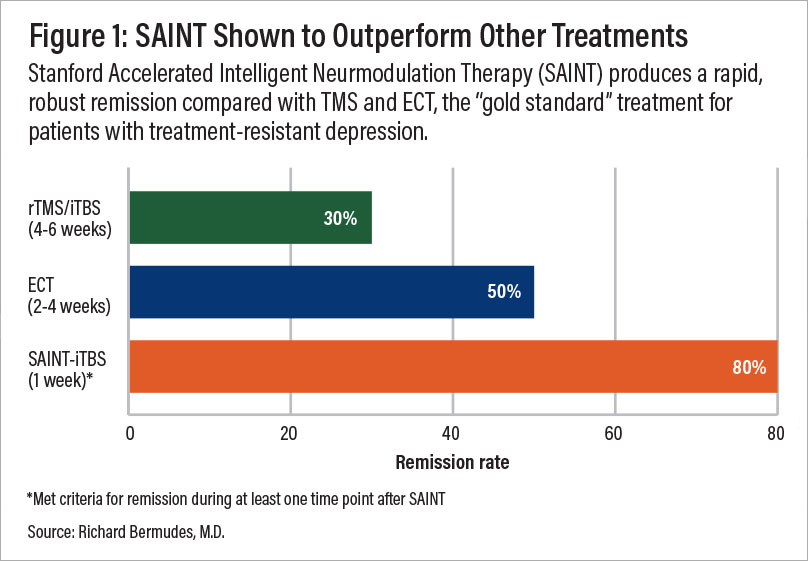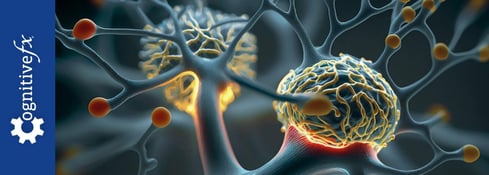What If TMS Doesn’t Work? Advice for Patients
If you’re wondering what to do when transcranial magnetic stimulation (TMS) doesn’t work, you might be:


Transcranial magnetic stimulation (TMS) is an established treatment to help patients struggling with major depressive disorder, obsessive-compulsive disorder (OCD), and other mental health conditions.
While many patients experience positive results from their treatment, it’s not uncommon for them to go through a temporary phase known as a “TMS dip,” where symptoms feel worse before they improve.
In this article, we break down what a TMS dip is, what might cause it, and how to cope during this period, so you feel more confident as you go through treatment. We understand that experiencing a dip can feel discouraging, but it’s important to know that it’s only a temporary effect.
Our clinic, located in Provo, Utah, offers the most effective form of TMS — accelerated fMRI TMS — at a significantly lower price than other clinics offering equivalent treatments. Learn more about our approach here, or take our quiz to see if it's the right depression treatment option for you.
The TMS dip is a temporary worsening of symptoms some patients experience during TMS therapy, usually after the 2nd or 3rd session. It’s generally mild and resolves on its own as treatment continues. It typically only lasts a few days, and very rarely, up to two weeks.
Repetitive transcranial magnetic stimulation (rTMS): The conventional TMS protocol, delivered once daily over 4–6 weeks. The dip often appears around weeks 2–3 and resolves by weeks 4–5.
Accelerated TMS: Involves multiple daily sessions over a shorter timeframe. The dip may occur within the first couple of days but tends to fade quickly.
Approximately 20–25% of patients experience a TMS dip. While frustrating, it’s often a normal part of the brain’s adjustment process and not a sign that the treatment is failing.
It's important to note that there are no published studies yet evaluating the TMS dip in terms of risk factors, prevalence, or resolution time. However, temporary symptom flare-ups are not unique to TMS; antidepressant medications can also cause similar effects during the initial adjustment period.
If your symptoms worsen, talk to your healthcare provider. Adjusting coil placement or stimulation intensity can help minimize the dip.
Common experiences during a TMS dip include:
Temporary increase in symptoms: Some patients may notice a temporary exacerbation of the symptoms they already have, such as heightened anxiety, low mood, or irritability.
Fatigue: Some patients may report increased fatigue or tiredness during the first few TMS sessions, which may affect their daily functioning.
New cognitive symptoms: The TMS dip may trigger cognitive issues, such as difficulty concentrating or brain fog.
New physical symptoms: Some patients may experience new physical symptoms such as sleep disturbances or changes in appetite.
TMS therapy is unlikely to worsen symptoms, but there are some situations other than a TMS dip where patients may feel worse after treatment. It’s not always easy to recognize whether patients are going through a short-term TMS dip or they’re developing more long-term adverse effects.
As a general rule:
In our view, a common cause of unintended symptom worsening is inaccurate coil placement. During a TMS session, the magnetic coil must be placed over a specific area of the brain called the dorsolateral prefrontal cortex (DLPFC). The goal of TMS is to stimulate nerve cells specifically in this region, to help restore normal function and alleviate depressive symptoms.
However, accurately pinpointing the DLPFC can be challenging. The most common targeting method used in conventional TMS, the 5 cm method, estimates the correct target location by manually measuring head landmarks.
While easy to implement, this approach is often imprecise due to individual variations in head size, shape, and brain structure. This means that, instead of targeting the DLPFC, magnetic pulses reach other neighbouring areas in the brain and cause unwanted symptoms.
Newer technologies—like neuronavigation with fMRI guidance, which we use at our clinic (more on that below)—improve targeting accuracy by using brain imaging to guide coil placement. This advancement significantly reduces the risk of imprecise brain stimulation, and the coil is placed in the correct location consistently for every TMS session.
It’s important for patients to be able to distinguish between a TMS dip and normal side effects of TMS therapy. This can be tricky, as both cause mild symptoms that tend to develop during the first few sessions and dissipate shortly thereafter.
TMS side effects do not involve a worsening of depression symptoms like the TMS dip, but typically include:
Serious side effects are extremely rare, but TMS therapy may increase the chances of developing mania in patients with bipolar disorder or cause a seizure in patients who have either an underlying neurological condition or a history of seizures.
If you’re experiencing any of these side effects, talk with your doctor about ways to make yourself more comfortable. This might include gradually increasing stimulation or adjusting the angle of the magnetic coil.
Further reading: Is TMS safe?
Researchers don’t know for sure what causes the TMS dip. There are likely to be a variety of factors, but at the moment, no studies have assessed how the brain changes during a TMS dip.
The most likely cause of a TMS dip is the brain beginning to rewire itself. In the early sessions, TMS disrupts dysfunctional neural pathways, which can temporarily worsen symptoms. This reaction often signals that the treatment is taking effect.
As treatment continues, the brain starts forming healthier connections, improving how different regions communicate to regulate mood more effectively. This process takes time, but it’s what ultimately leads to lasting symptom relief.
Think of it like starting a strength training program: at first, you might feel sore, but with persistence, your body gets stronger. TMS works similarly—temporary discomfort can be a sign that positive changes are underway.
Brain chemistry: Another possibility is that individual differences in the patient’s brain chemistry and responsiveness to TMS could play a role in the occurrence of the TMS dip.
Adjustment period: Like other therapies, TMS requires time for the brain to adapt. During this time, patients may experience fluctuations in mood and other symptoms.
Severe symptoms: There is some anecdotal evidence that the TMS dip is more likely in patients starting their treatment with severe apathy or borderline catatonic symptoms. It seems that patients feel worse because they are actually starting to feel again.
Side effects: As described earlier, TMS side effects are mild and usually short-lived. However, occasionally, patients experience pain and severe discomfort during their TMS sessions, intensifying the feelings of restlessness, worry, or unease, which can be confused for a TMS dip.
High expectations: In some cases, patients report feeling worse because they’re not experiencing improvements as fast as they were expecting.
There’s currently no evidence that TMS dips can be prevented—even with advanced protocols like accelerated fMRI TMS.
However, precision targeting using fMRI and neuronavigation (such as with the SAINT™ protocol) helps optimize treatment and reduce variability in patient response. Developed at Stanford in 2022, this approach produces outstanding outcomes.
In clinical trials:
This shows that even if a dip occurs, long-term success is still very possible.

A comparison of remission rates for rTMS/iTBS, electroconvulsive therapy (ECT), and SAINT-iTBS.
A TMS dip does not mean that the treatment isn’t working or that your case of depression cannot be treated. As we described earlier, it can be a sign that your TMS sessions are effectively changing your brain.
In general, sticking with your treatment plan allows you to overcome the dip and start experiencing the full benefits of TMS, including:
However, there are exceptions, such as extreme cases of increased anxiety, where it can make sense to delay the rest of the treatment or end it early. This can be determined through discussion with your practitioner.
Further reading: How long does it take for TMS to work?
There is no doubt that going through a TMS dip can be challenging for patients. Here are a few strategies to help you navigate this phase:
Communicate with your TMS provider: Maintaining good communication with your TMS provider is crucial. Once you start your treatment, keep track of how you’re feeling. If your symptoms change or you notice new symptoms, let your doctor know. Sharing these changes with your doctor allows them to adjust your treatment if needed.
Be patient: Remember the dip is temporary and often a sign that your brain is responding.
Make healthy lifestyle choices: Incorporate healthy choices in your daily routine, such as regular exercise, adequate sleep, a balanced diet, and social activities. Supporting your well-being throughout treatment will allow you to better manage unexpected hurdles, such as a TMS dip.
Lean on your support system: Rely on your support network, including friends and family, during your treatment. This can provide comfort and encouragement throughout your journey. Having someone to lean on when you need it most can make the treatment easier to manage.
Practice stress management: Find ways to reduce stress in your life. For example, practice mindfulness, deep breathing, or relaxation techniques to help you deal with temporary fluctuations in symptoms.
Attend talk therapy: Seeking out psychotherapy, such as cognitive behavioral therapy (CBT), helps patients manage their emotions and make sense of temporary setbacks like the dip.
Set realistic expectations: Set realistic expectations and focus on the progress you have made throughout treatment. Understand that the TMS dip is a normal part of the process and does not indicate that your treatment failed.
Our clinic, Cognitive FX, based in Provo, Utah, is proud to be among the first in the nation to offer a reliable alternative to the SAINT™ TMS treatment at a fraction of the cost.
The only difference between our treatment and the revolutionary SAINT™ protocol (a trademark licensed to Stanford Medical) is our targeting method. Our target locations are determined by fMRI and our prescribing neuroscientist and physician, rather than their proprietary software.
Our accelerated fMRI-guided protocol is:
Safe: Widely tolerated and associated with mild, short-lasting side effects.
Precise: fMRI ensures that the treatment target area is precisely located for each patient, accounting for variations in head size and shape. Neuronavigation ensures the magnetic coil is placed over that exact spot for every treatment session.
Fast: Treatment courses are reduced to a single week, making it easier to complete alongside life and work commitments (compared to 4 to 6 weeks of standard TMS and accelerated TMS protocols).
Effective: Precision coil placement combined with theta burst stimulation produces the best TMS treatment results to date.
To improve outcomes for our patients, we also include cognitive behavioral therapy (CBT) as a part of our treatment. When combined with the traditional method of TMS (rTMS), CBT improved response and remission rates by ~8% and ~19%, respectively. Additionally, CBT is likely to produce sustained improvement over time once treatment has concluded.
Our brain stimulation treatment is ideal for most patients with treatment-resistant depression. However, we do not treat patients under the age of 18 or over 65. Furthermore, as a safety measure, we do not treat patients who have a history of seizures or who are currently actively suicidal and in need of crisis care.
Learn more about our approach here, or take our quiz to see if you’re a good fit for receiving accelerated fMRI TMS therapy at Cognitive FX.

Dr. Mark D. Allen holds a Ph.D. in Cognitive Science from Johns Hopkins University and received post-doctoral training in Cognitive Neuroscience and Functional Neuroimaging at the University of Washington. As a co-founder of Cognitive Fx, he played a pivotal role in establishing the unique and exceptional treatment approach. Dr. Allen is renowned for his pioneering work in adapting fMRI for clinical use. His contributions encompass neuroimaging biomarkers development for post-concussion diagnosis and innovative research into the pathophysiology of chronic post-concussion symptoms. He's conducted over 10,000 individualized fMRI patient assessments and crafted a high-intensity interval training program for neuronal and cerebrovascular recovery. Dr. Allen has also co-engineered a machine learning-based neuroanatomical discovery tool and advanced fMRI analysis techniques, ensuring more reliable analysis for concussion patients.

If you’re wondering what to do when transcranial magnetic stimulation (TMS) doesn’t work, you might be:

If you’re considering Transcranial Magnetic Stimulation (TMS) — a procedure that uses electromagnetic pulses to improve depression symptoms — you may be wondering what the treatment actually feels...

With the original form of TMS therapy for major depressive disorder—known as repetitive transcranial magnetic stimulation (rTMS)—some patients begin noticing improvements within the first week of...

A major challenge for patients with depression is that traditional antidepressant medications often take weeks or months to show results — if they work at all. This delay can be especially...

Patients considering transcranial magnetic stimulation (TMS) often wonder whether or not they can continue taking their antidepressant medication while undergoing TMS treatment.

If you’re considering accelerated Transcranial Magnetic Stimulation (TMS) therapy, it’s important to understand how it works, what to expect, and whether it’s the right fit for you.